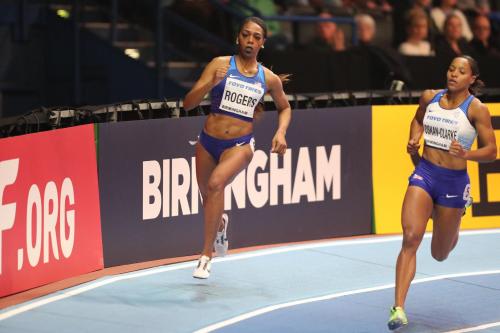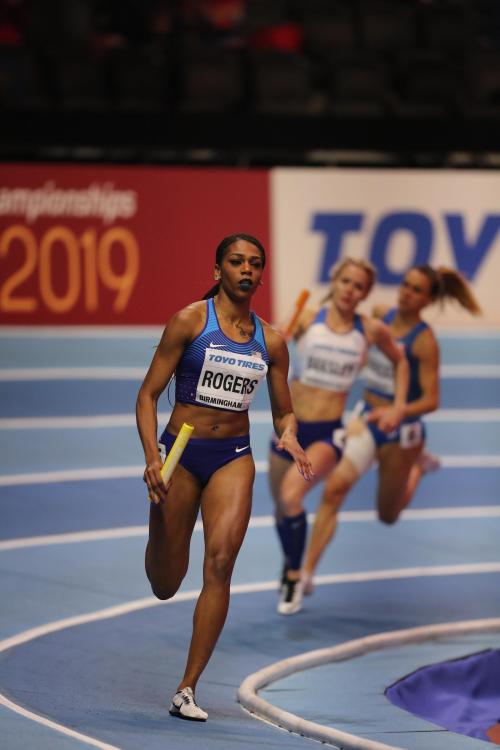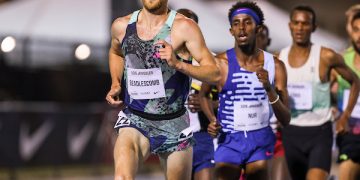 Raevyn Rogers, photo by Martin Bateman
Raevyn Rogers, photo by Martin Bateman
This is a fun interview by Stuart Weir, the second of the week, on Raevyn Rogers, the amazing WC silver medalist at Doha 2019!
Raevyn Rogers
1. How did you start running?
I started running when I was five. I played T-ball, which is like baseball for little kids. In the park where we played there was a running track. When the T-ball season was over, my mom got me involved in track. So I’ve been running since I was five and it started because I saw other kids running.
2. Why the 800?
I think it was because I wasn’t fast enough for 100 and 200, so I tried 400 and 800. And there weren’t so many kids doing the 800 – and even I didn’t really want to run two laps! But basically I chose 800 because I wasn’t fast enough to be a sprinter.
3. In 2013 you won medals at the PanAM juniors and the World Youths. How significant was that for your development?
Doing something international was big, so that was a real break out, especially the World Youths because that was the first time I’d ever been out of US – and been on a US team.
But before that, when I was 12 or 13, I was too young for World Youths but I had run the times. When I was 13 I had run 2:06 and that was a breakout moment when people started noticing who I was. In the south there are not enough competitions to help exposure unless you go to the New Balance nationals. So my mom used to take me to track meets and that was where I used to get some competition. At the same meet that I ran 2:06, I ran 52 and people were like “where did she come from?” So I would say that was a breakout in my career and the Pan Am and World Youths were my international breakout.
4. Being an Oregon Duck – was that a good experience?
The highlight was really just being part of that culture. I’m the type of person who enjoys watching track with my family but I’d rather not consume myself in it. So when I get a chance to back away from the sport and do other things like painting or be out with friends I’m happy with that. But being at Oregon was a huge experience because there is so much history from Prefontaine and you have Ashton Eaton, Galen Rupp, English Gardner, Phyllis Francis and so on. There are so many legends who have passed through Oregon and been successful so just being there and being part of it was great. I think my biggest thing going into it is that I’d decided that me being a freshman was not going to be an excuse for settling for less than I could. So that was why my goal was to win NCAAs no matter how I crazy it sounds for a freshman to do that. But I didn’t want to limit myself. So being in Oregon really challenged me in terms of how high I wanted to go.
5. USAs 2017 fourth in a very fast race. Was that a big disappointment?
I was extremely disappointed because that was the same year that I triple crowned and USAs were two or three weeks after that. In 2016 I had missed the US Olympic team by two spots, so in my head I was going to come back in 2017 and get it. So to miss it yet to be in the race to qualify for the world championships and then just tire, I was completely devastated. Mentally I knew I could make the team but physically my body was a little bit more realistic – that I was coming off a full collegiate year. `I was devastated especially missing out by one spot. But it taught me a lot about patience and purpose just in terms of trusting the process. I’m able to tell people my story, how I missed the team by one spot three years ago and now I’m a world silver medalist. It shows me there is a bigger plan and it wasn’t a failure but it played into where I’m trying to go.
6. Birmingham World Indoors – what was your assessment?
The first thing to say is that I was excited to make the US team because that was the first professional international team I had made and in my first year after going pro. Making the final was a bit of a ‘deer in the headlights’ experience. I had run professionally before while I was college but I was still in college so it was different. Birmingham was the real deal of what professional track running is – you are away, out of your country, representing the USA on the big stage. The World Indoors is a well-respected event. So, it was a real eye opener in terms of intensity. It was clear that people had not come to play! Of course, I knew that before but this was an actual scenario that I was in and it was the final. It was taken seriously. I was able to realize afterwards that people were treating it the same way as you would the Olympics. I had done USAs and USAs are intense because the US team is a very hard team to make but it’s different when there are just a few of you in a final and you are running against people from other countries and they have a different type of motivation as well. Some are running was a real aggression or motivation which really causes them to go after it. And that is something that I was first exposed to at the 2018 World Indoors.
7. In Birmingham you got to relay medal – do you enjoy relays?
I do enjoy running relays especially as they have been such a big part of my career. It’s funny, though. People ask me what my 400 PR is but I don’t have many 400 times because I don’t run many open 400s. I mainly run relays. I think relays are fun because people can see that I have what it takes to be a 400 runner, the kind of speed and the heart that I have when I’m in a relay. Hopefully I might be on an Olympic relay team one day. That would be a lot of fun.
8. In Monaco 2018 – you ran a PR but finished seventh. How do you remember that amazing race?
I remember that I was in the outside lane – lane eight. I think that was my first time running in Monaco. I had heard the hype about Monaco being a very fast track. Because my family and I watch a lot of track, I had watched races from Monaco. But actually being there and at night time – it just somehow has a different atmosphere and Monaco’s the track where Ajee had set the American record. And Caster was in the field.
I had the same feeling I’ve had at the indoor worlds, that people were not coming to play! They had come to go after it, knowing that was a track where they were fast times. So it’s a track where people want to go after it to see what they get.
After the race I was excited that I had PRed and people were saying “running 1:57 for seventh place is insane”. But afterwards I was thinking more about having run 1:57 than about what place I got.
 Raevyn Rogers, photo by Martin Bateman
Raevyn Rogers, photo by Martin Bateman
9. Does it change the way races are run that Caster isn’t there any more?
It doesn’t affect me but I can’t speak about how it might affect other people. It doesn’t affect me because it’s not like I was front running with her anyway. You can’t tie yourself up worrying about one person in a race. If you don’t focus on yourself you will miss out. I never focus on other people in a race. I think that was the coach’s job – to see who else is in the race and to guide you in a way that you can do
10. You train with Ajee. Is it difficult then competing against her?
We get along great. We have a tight bond and a tight relationship and we respect each other’s place in track. We recognize that everyone is on their own path and we never get to a place where we’re crossing paths. It only gets difficult when you compete and you wanted to do better than you actually did. But that’s more something you have to deal with yourself then deal with, with her.
People might think it’s hard to train with somebody as talented as Ajee or to compete against her when you train with her. But the reality is there’s no ill-will and no malicious intent in our relationship. So no matter how well one of us does the race it never gets to that point.
11. Do you have any faith or beliefs?
I was raised in a Baptist church. My faith has always been there and I pray before my races. That’s the foundation I’ve had since I was little. I feel that I have begun to work on my relationship with God by committing and being devoted to hearing perhaps since I was 16. It is something that has grown.
When I moved to Philadelphia it was a little bit difficult. I know as Christians you’re always going to be challenged. At that stage my relationship with God needed to be stronger. In Oregon I always went to church on Sundays and had a run later on but in Philadelphia we practice on Sunday mornings. So that was harder for me. It caused me to really put an effort in to watch videos or watch my pastor – just making that effort to make sure I’m still getting that knowledge to make my relationship with God strong, the way it needs to be. At this point I feel it’s a growing thing.
12. Have you still been able to train in lockdown?
The biggest thing at is making sure I have a routine and continue training. Once the virus came to the US I expected this to happen [everything to close down]. At first it was a little hard because people didn’t know what was happening. Now they have seen the new schedule of Diamond Leagues. I’ve been taking it one step at a time because even with the new schedule, we don’t really know. I stick to my own routine and just try to get the most out of it and to make sure that my mental attitude is right.
The track where I usually train closed and in Philadelphia they extended the ‘stay at home’ order to June. I’m going on runs and doing some training on grass – mainly runs, just on my own. The training group, we haven’t seen each other in a while other than on video calls.
12. How did you feel when it was announced that the Olympics were postponed?
I sort of expected it so I wasn’t really surprised. We always knew this year would be short because we didn’t resume training until November and then there was Thanksgiving and Christmas break. I missed perhaps three weeks out of December. When you come back in January you’re into indoors but there were not many indoor races this year. I really sympathize with those in college who won’t get a chance to do NCAA.
13. Can you the way tracks of different shapes affect your race plans?
It’s funny because people say whatever the shape of the track it is still 400m. But it can be narrow or the infield can be wider so that the curves are longer. You can have tracks where the curves are narrower and the straights are longer. On the other, and take Penn for example, where the straights are short but the curves are extremely long. The thing is that you don’t really learn about tracks until you’ve run on them. So when we go to practice before a race I like to go and see how the track is set up because every track is different. With the indoor tracks they may be banked or not banked as well as the same questions as outdoor.
14. What are you like as a person?
I enjoy relaxing at home or being with friends or family. I enjoy traveling and of course I enjoy painting. I want to dedicate a painting space instead of just doing it in my living room. I think I will thrive more with my painting when I dedicate a space to it. I’m more of an abstract painter but I paint whatever comes to mind, whatever I think will look really cool.
15. Do the different shapes of tracks affect your race plans?
It’s funny because people say whatever the shape of the track it is still 400m. But it can be narrow or the infield can be wider so that the curves are longer. You can have tracks where the curves are narrower and the straights are longer. On the other, and take Penn for example, where the straights are short but the curves are extremely long. The thing is that you don’t really learn about tracks until you’ve run on them. So when we go to practice before a race I like to go and see how the track is set up because every track is different. With the indoor tracks they may be banked or not banked as well as the same questions as outdoor.
Author

Since 2015, Stuart Weir has written for RunBlogRun. He attends about 20 events a year including all most global championships and Diamond Leagues. He enjoys finding the quirky and obscure story.
View all posts




















